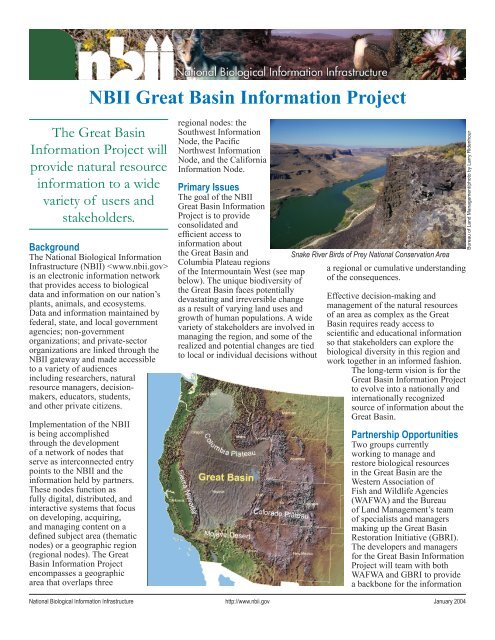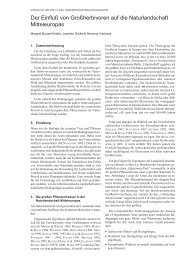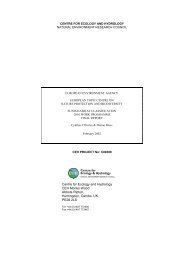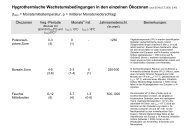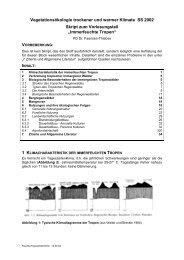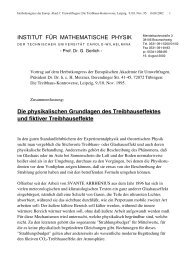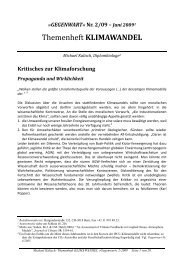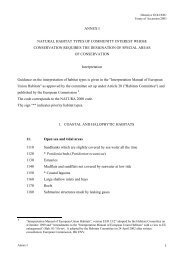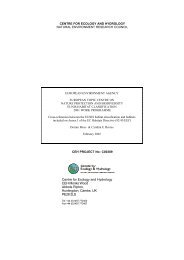NBII Great Basin Information Project - TU Berlin
NBII Great Basin Information Project - TU Berlin
NBII Great Basin Information Project - TU Berlin
You also want an ePaper? Increase the reach of your titles
YUMPU automatically turns print PDFs into web optimized ePapers that Google loves.
<strong>NBII</strong> <strong>Great</strong> <strong>Basin</strong> <strong>Information</strong> <strong>Project</strong>The <strong>Great</strong> <strong>Basin</strong><strong>Information</strong> <strong>Project</strong> willprovide natural resourceinformation to a widevariety of users andstakeholders.BackgroundThe National Biological <strong>Information</strong>Infrastructure (<strong>NBII</strong>) is an electronic information networkthat provides access to biologicaldata and information on our nation’splants, animals, and ecosystems.Data and information maintained byfederal, state, and local governmentagencies; non-governmentorganizations; and private-sectororganizations are linked through the<strong>NBII</strong> gateway and made accessibleto a variety of audiencesincluding researchers, naturalresource managers, decisionmakers,educators, students,and other private citizens.Implementation of the <strong>NBII</strong>is being accomplishedthrough the developmentof a network of nodes thatserve as interconnected entrypoints to the <strong>NBII</strong> and theinformation held by partners.These nodes function asfully digital, distributed, andinteractive systems that focuson developing, acquiring,and managing content on adefined subject area (thematicnodes) or a geographic region(regional nodes). The <strong>Great</strong><strong>Basin</strong> <strong>Information</strong> <strong>Project</strong>encompasses a geographicarea that overlaps threeregional nodes: theSouthwest <strong>Information</strong>Node, the PacificNorthwest <strong>Information</strong>Node, and the California<strong>Information</strong> Node.Primary IssuesThe goal of the <strong>NBII</strong><strong>Great</strong> <strong>Basin</strong> <strong>Information</strong><strong>Project</strong> is to provideconsolidated andefficient access toinformation aboutthe <strong>Great</strong> <strong>Basin</strong> andColumbia Plateau regionsof the Intermountain West (see mapbelow). The unique biodiversity ofthe <strong>Great</strong> <strong>Basin</strong> faces potentiallydevastating and irreversible changeas a result of varying land uses andgrowth of human populations. A widevariety of stakeholders are involved inmanaging the region, and some of therealized and potential changes are tiedto local or individual decisions withoutSnake River Birds of Prey National Conservation Areaa regional or cumulative understandingof the consequences.Effective decision-making andmanagement of the natural resourcesof an area as complex as the <strong>Great</strong><strong>Basin</strong> requires ready access toscientific and educational informationso that stakeholders can explore thebiological diversity in this region andwork together in an informed fashion.The long-term vision is for the<strong>Great</strong> <strong>Basin</strong> <strong>Information</strong> <strong>Project</strong>to evolve into a nationally andinternationally recognizedsource of information about the<strong>Great</strong> <strong>Basin</strong>.Partnership OpportunitiesTwo groups currentlyworking to manage andrestore biological resourcesin the <strong>Great</strong> <strong>Basin</strong> are theWestern Association ofFish and Wildlife Agencies(WAFWA) and the Bureauof Land Management’s teamof specialists and managersmaking up the <strong>Great</strong> <strong>Basin</strong>Restoration Initiative (GBRI).The developers and managersfor the <strong>Great</strong> <strong>Basin</strong> <strong>Information</strong><strong>Project</strong> will team with bothWAFWA and GBRI to providea backbone for the informationBureau of Land Management/photo by Larry RidenhourNational Biological <strong>Information</strong> Infrastructure http://www.nbii.gov January 2004
photo by Terry Steele (also the sage grouse in the banner)Sage grouseresources needed by these groups tofacilitate their efforts. Other potentialpartners include many local, state, andfederal agencies, universities, and nonprofitorganizations.ProductsThe <strong>NBII</strong> <strong>Great</strong> <strong>Basin</strong> <strong>Information</strong><strong>Project</strong> will create a Web-accessiblegateway to biological informationfor the <strong>Great</strong> <strong>Basin</strong>. The initial focuswill be on development of a Web site,a metadata server, a bibliography,and an educational Internet mapper.These four components will serveas the groundwork for an Internetaccessible<strong>Great</strong> <strong>Basin</strong> <strong>Information</strong><strong>Project</strong> that will provide immediatebenefits to a wide variety of usersand stakeholders in the region. Whenfully implemented, the <strong>Project</strong> willprovide natural resource informationfor much of Idaho, Oregon, Utah,California, and all of Nevada. Theexpanded project will be state-of-theart,designed to serve relevant data andprovide for custom analysis tools.Features:Web site: The Web site will bedesigned to provide acomprehensive overview ofthe <strong>Great</strong> <strong>Basin</strong>. This includesa variety of information on naturalresources, history, cultures, andresource sharing issues.Astragalus purshiiqueried from the Web site. It willinclude metadata for spatial andbiological data that overlay theextent of the <strong>Great</strong> <strong>Basin</strong>.Bibliography: The bibliographywill focus on the <strong>Great</strong> <strong>Basin</strong> andinclude papers from scientificjournals, theses and dissertations,government publications, andarticles from popular magazinesand newspapers. Users will beable to search the bibliographyfor items that match a set ofcriteria selected by the user.Educational Internet Mapper:This Internet mapping applicationis intended for educational useto help visualize the geology,water, vegetation, and other issuesin the <strong>Great</strong> <strong>Basin</strong>.Although a prime focus of the <strong>NBII</strong> ison biological data, the <strong>Great</strong> <strong>Basin</strong><strong>Information</strong> <strong>Project</strong> will bestrengthened by data on geology,hydrology, geography, and the humandimension. As such, it provides aphoto by David Pykeframework for increased stakeholderinteraction. The establishment of the<strong>Great</strong> <strong>Basin</strong> <strong>Information</strong> <strong>Project</strong>exemplifies the <strong>NBII</strong>’s role as aninternational leader in the disseminationof scientific information.More information on the naturalresource issues affecting the <strong>Great</strong><strong>Basin</strong> can be found in the 70-pagepublication Research Plan for LandsAdministered by the U.S. Departmentof the Interior in the Interior Columbia<strong>Basin</strong> and Snake River Plateau (availableat ). Thereport was published in 2002 andwritten by E. Beever and D. Pyke(USGS/BRD/ITR-2002-0003; U.S.Geological Survey, Forest andRangeland Ecosystem Science Center,Corvallis, OR).For More <strong>Information</strong>Tom ZarrielloUSGS Forest and RangelandEcosystem Science CenterPhone: 208-426-5204E-mail: tom_zarriello@usgs.govLinda SchueckUSGS Forest and RangelandEcosystem Science CenterPhone: 208-426-3353E-mail: linda_schueck@usgs.govJulie Prior-MageeUSGS/Biological Resources DisciplinePhone: 505-646-1084E-mail: jpmagee@nmsu.eduFind us on the Web at:.Metadata Server: The GBIPwill identify geospatial data thatis important to the project,determine whether it has correctand/or complete metadata, anddetermine the best course ofaction to correct and/or completeincomplete metadata sets. Thegoal is to create a full-fledgedmetadata server that can beSunset in West-Central Nevadaphoto by Erik Beever


